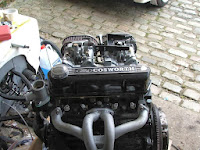Related to an automobile engine, we can use an oxygen sensor, more commonly
known as lambda sensor to measure how much oxygen is left in the exhaust gases.
If we return this data to the engine management system, the ECU can adjust the
quantity of injected fuel.
The use of the engine determines what is done with that data.
Starting from the middle, this means that 14.7 parts of air will burn together
with 1.0 part of fuel. This means lambda = 1 (λ=1). More air means a
leaner mixture, less air (or more fuel) means a richer mixture. So next time
you’re sitting together with those petrolheads talking about their engine
running a little bit too rich or lean, you at least know what they are talking
about!
There are advantages to run an engine lean or rich, but extreme values for too much time may damage the engine. Management systems can be run to take in account lambda values more or less. You decide wether you want the best power or the best fuel economy or a compromise of both.
There are advantages to run an engine lean or rich, but extreme values for too much time may damage the engine. Management systems can be run to take in account lambda values more or less. You decide wether you want the best power or the best fuel economy or a compromise of both.

Modern systems use a large band oxygen sensor. They have to be connected to a controller to have a usable signal for the ECU. The pic shows how it is connected to an Emerald ECU only for example. Other ECUs and controllers may have different pin-outs. The showed pin (35) can be configured internally to be used with a lambda sensor.
Cheers.


















































